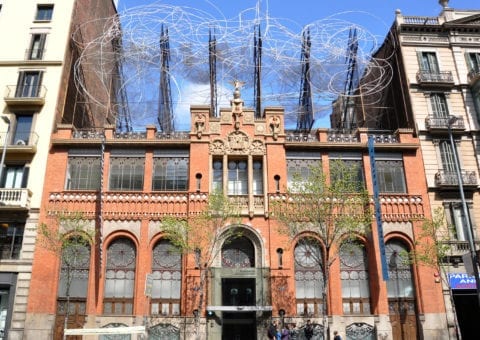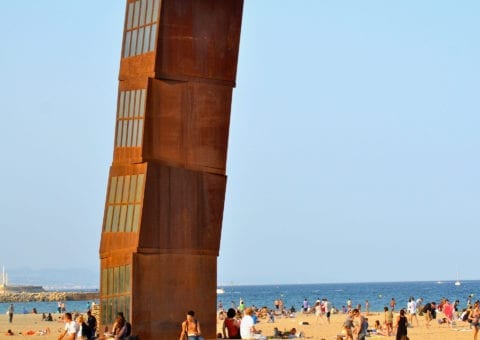It is located in the old enclosure of the Roman wall.
It was the first palace of the Counts of Barcelona and later reformed by Jaume II who had the chapel we know today as Santa Àgata built, at the time it was born with the name of Santa María del Palau Reial Major. Pedro IV the Ceremonious finished the reforms of the palace culminating in 1359 with the “Great Room”, the current Saló del Tinell.
If we look up we will see a tower on top, it is the Torre del Mirador del Rey Marti, with five floors it was an authentic skyscraper of the time. Despite bearing the name of King Marti, the tower was built 150 years after his death.
The kings of Aragon also resided until the union of the Kingdom of Castile with the marriage in 1469 of Fernando II of Aragon and Isabel II of Castile who transferred the court to Castile.
The Plaza and its uses:
In the 3rd and 4th centuries there was a salt fish factory, the remains can be found in the underground of the square.
In the 6th century it was occupied by a necropolis.
In the eleventh century used as a corral.
It was used for the meetings of the Consell de Cent before the construction of the current Saló de Cent in the 14th century.
It was a market and trading center for fodder and straw.
We owe the rectangular shape of the square to King Marti, who adapted it for the celebration of “jousts”, tournaments on horseback with a spear.
In 1837, the first bullfight in Barcelona was held in the square.
In 1853, a neo-Gothic fountain was installed in the center of the square. Later, with part of the important reform of 1934, the fountain was removed, in 1986 a sculpture by Eduardo Chillida “TOPOS V” was installed, which currently presides over the square.
Tinell Hall:
Impressive Gothic room, characterized by six arches. It is part of the buildings that group the Palacio Real Mayor.
Year of construction from 1359 to 1370.
Supposedly it is where the Catholic Monarchs received Christopher Columbus on his return and his first voyage to the Americas.
Seat of the Inquisition in the 16th century.
It was used by a community of nuns until 1935
It is currently used for holding exhibitions, concerts, celebrations and other events, it has a capacity for 400 people.
Chapel of Santa Agata:
The works began in 1302, built by the master builder Bertran Riquer commissioned by King Jaime II of Aragon.
Built on the old Roman wall, which had lost its defensive function.
Catalan Gothic style chapel.
Rectangular nave and polygonal apse with vaults.
Octagonal bell tower imitating the king’s crown.
We can see 70 tiles with representations of angels and weapons, the work of Juan Claperós.
Impressive altarpiece by Jaume Humet from the 15th century “El Retablo del Condestable”.
Holy Agatha:
Your name means; the good, the virtuous.
Originally from Sicily, probably from Catania.
Her martyrdom is found in the document “Passio Santa Agathae”.
She decided to keep her virginity for the love of God.
The proconsul Quimtiemus took a fancy to her and here began her problems.
She refused to worship pagan gods, reaffirming her Christian faith.
Her martyrdom: her They burned her breasts and cut them off with tongs.
She is the patron saint of women.
Casa Clariana-Padellas:
King’s Square
It houses the Museum of History of Barcelona.
In the 19th century, due to the works on the Vía Layetana, Casa Padellas was moved stone by stone from Mercaders Street to Plaça del Rei, however important Visigoth and Roman remains were found during the foundation works. These archaeological finds, together with the interventions in the Palacio Real Mayor, led the Barcelona History Museum (MUHBA) to its current location in 1943, where we can contemplate and document the more than 2,000 years of history of the city.
http://ajuntament.barcelona.cat/museuhistoria/ca
Palau del Lloctinet
(Lieutenant’s Palace)
Late Gothic building with Renaissance elements.
The craftsmanship of the stairs is remarkable.
It dates from 1549 and was built next to the Palacio Mayor Real commissioned by Carlos I of Spain V of Germany, as the seat of the Viceroy, his representative in Catalonia.
Part of the stones of its façade come from the old Jewish cemetery of Montjuïc.
It was the seat of the Inquisition.
From 1836 to 1993 it housed the headquarters of the Archive of the Crown of Aragon, which until 1770 was located in the Palacio Real Mayor. Due to the need for space, in 1993 a new office was incorporated into the archive on Calle Almogávares, so the archive currently has two offices.
Did you know?
On the façade facing Comtes street, we can see some pornographic figures with images such as a fellatio to a strange creature, or another sculpture of two children.





